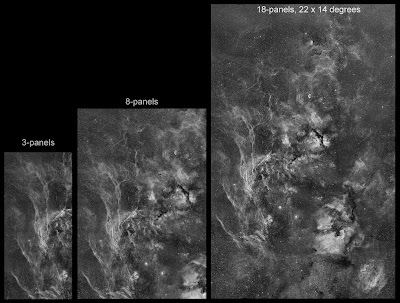22 x14 degrees of sky from the constellation Cygnus
The "Chinese Dragon Nebula"
H-alpha emission, 18 panels, mosaic image of Nebulae in Cygnus
Download link for the 2600x3950 pixels image HERE. (Note, about 7,3 meg)
The noise in a background, is not a noise but countless number of stars!
I was busy last night
I started to image about Four a clock! Up here, it's dark enough for astronomical imaging at that time.
My previous project, an eight panel mosaic of Cygnus Nebulae, is starting to grow! I was not planning to shoot so large mosaic but since the first one turned to be so good and funny to do, lots of work though, I decided to go on. The Canon EF 200mm f1.8 lens is very fast optically, so the needed exposure time per panel is reasonable. I shot all 12 new panels between Four and Two a clock , Ten hours straight, no pauses.
I will shoot other channels, S-II & O-III, little by little. If weather cooperate, I might have this ready before Christmas. This is the largest mosaic, I have done so far.
The "Chinese Dragon Nebula"
Do you see a Chinese Dragon in upper image?
Some technical information about the image
- Original size for the 18 panels mosaic 14.000 x 9000 pixels
- Resolution 5,5 arch seconds / pixel
- Image center, RA 20h 27s, Dec 43d 30m 45s
Area of this image is about 22 x14 degrees of sky.
Full Moon has an angular diameter of 0,5 degrees, it fits to the area of this image about 1230 times!
Start of the Cygnus project
I started the Cygnus mosaic project by shooting a three panel mosaic from the "Cirrus area"
Blog post can be seen here: http://www.astroanarchy.blogspot.com/2011/11/cirrus-of-cygnus-project-finalized.html
Image in mapped colors, H-a = Green, S-II = Red and O-III = Blue
The second phase was an eight panel mosaic. The blog post can be seen from here:
Eight panel mosaic. This image gives an idea, how the large mosaic will look in colors.
Technical details for the 18 panel mosaic
I have used a very fast camera optics, Canon EF 200mm f1.8, full open to collect all the data in this mosaic. Due that, total exposure time is relatively short, ~12h, there are some very dim formations clearly visible.
Processing work flow:
Image acquisition, MaxiDL v5.07.
Stacked and calibrated in CCDStack2.
Levels, curves and mosaic combine in PS CS3.
Optics, Canon EF 200mm camera lens at f1.8
Camera, QHY9
Image Scale, ~5,5 arcseconds/pixel
Guiding, Meade LX200 GPS 12" and a Lodestar guider
Filter, Baader 7nm H-alpha
Panel 1
H-a, 3x900s Binned 1x1
Panel 2
H-a, 5x900s Binned 1x1
Panel 3
H-a, 3x900s Binned 1x1
Panel 4
H-a, 4x900s Binned 1x1
Panel 5
H-a, 5x900s Binned 1x1
Panel 6
H-a, 8x900s Binned 1x1
Panel 7
H-a, 6x900s Binned 1x1
Panel 8
H-a, 4x900s Binned 1x1
Panel 9
H-a, 4x900s Binned 1x1
Panel 10
H-a, 3x900s Binned 1x1
Panel 11
H-a, 3x900s Binned 1x1
Panel 12
H-a, 3x900s Binned 1x1
Panel 13
H-a, 3x900s Binned 1x1
Panel 14
H-a, 3x900s Binned 1x1
Panel 15
H-a, 3x900s Binned 1x1
Panel 16
H-a, 3x900s Binned 1x1
Panel 17
H-a, 3x900s Binned 1x1
Panel 18
H-a, 3x900s Binned 1x1
Total exposure time for all panels ~12h
Top of light exposures, there are calibration files shot.
21 Flat frames
99 Bias frames
19 Dark frames
NOTE.
No star or noise reduction, nor sharpening, are used.







0 comments:
Post a Comment